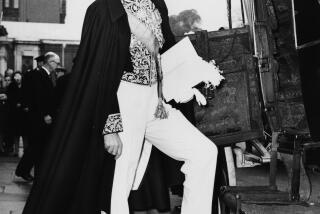Iranians Get Their First Look at Shah’s Favorite Palace
- Share via
TEHRAN — Two old gardeners leaned on an ornamental lamppost and smiled at the crowd of Iranians filing into the ousted shah’s favorite palace.
“This really makes me happy,” one of them said. “Before, this whole place was just for five people. We had to keep out of sight.
“Now it belongs to everybody and I can stand here watching the people, and nobody can order me not to.”
Seven years after the 1979 revolution that threw out Shah Mohammed Reza Pahlavi, Iranian authorities have decided to open up the Niavaran Palace, where the shah and his family lived in the cool of north Tehran for nine months of the year.
‘Spendthrift Life’
The doors opened to the public this month, officially to display the “spendthrift and ceremonial life” of the late shah, who died in exile in Egypt in 1980.
The square, stone-faced palace and 50 acres of wooded lawns and rose beds have been kept in immaculate condition, just the way they were on the morning in January, 1979, when the shah and his family fled.
Local militia protected Niavaran’s priceless contents from the mobs, and Iran’s conscientious museum service now manages the palace. Many of the shah’s gardeners and retainers still work there.
Revolutionary police in crumpled fatigues guard the iron gates, oblivious to rusting closed-circuit TV cameras surrendered by the frightened remnants of the shah’s guard.
27 Months of Cataloguing
The militia stood guard as officials spent 27 months cataloguing everything inside, including Sevres porcelain, Czech chandeliers, Gobelin tapestries, antique Persian silk carpets valued at up to $2 million and manuscripts worth $3 million.
Crowds have waited in line for hours, paying 100 rials (about $1) to see how the Pahlavis lived. Some seemed disappointed that the seven-bedroom palace was not more opulent.
Guides explained that many precious items were not on display, including a gold telephone from the shah’s desk and gold bathroom taps.
These and other other valuable artifacts were moved to the Central Bank, they said.
Built as Guest House
“This is just one part of what the shah robbed from this country,” a turbaned Shia Muslim clergyman said. “Compare this palace with the small rented house of Imam Khomeini.”
It was the Ayatollah Ruhollah Khomeini who led the Islamic revolution that toppled the Pahlavi dynasty from the Peacock Throne.
The palace lacks individual style, possibly because it was originally built as a government guest house.
The shah’s wife, Farah, chose a formal French style for the interior, built around a large two-story hall. Her bedroom looks like a miniature Versailles, with antique French furniture and a gold brocade cover on a canopied bed.
150 Dress Uniforms
Paris decorator Mercier Freres did the shah’s bedroom next door in the same style. But curiously his bed was set into a deep recess in the wall and shut off with a thick blue curtain.
His passion for military clothing was shown in a nearby wood-and-glass paneled room, where some 150 dress uniforms still hung in mothballs.
A brass plaque labeled it the “dressing room of the annihilated shah.”
Large portraits of the shah and his family--his relatives are in exile in France and the United States--have been left just where they hung on the walls.
But a small picture of Khomeini on the hall table of Niavaran Palace shows who is now in charge.
More to Read
Sign up for Essential California
The most important California stories and recommendations in your inbox every morning.
You may occasionally receive promotional content from the Los Angeles Times.













